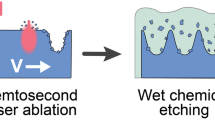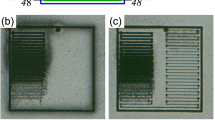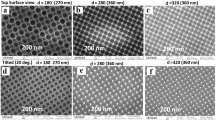Abstract
Nanostructured near-IR antireflective layer was produced on a GaAs slab surface by direct femtosecond laser fabrication of a surface diffraction grating. The single nanostructured layer on the GaAs slab reduces its total reflection at the wavelength λ ≈ 2.5 μm by 42 %, in agreement with the second-order approximation of the effective medium theory, with negligible increase of its absorbance.
Similar content being viewed by others
Avoid common mistakes on your manuscript.
1 Introduction
Anti-reflection (AR) coatings on near- and mid-IR optical GaAs elements are useful for reduction of their significant (tens of percent) reflective energy losses. Surface subwavelength gratings are well known as AR coatings in their zeroth diffraction order [1]. Such gratings on flat surfaces are generally produced by interferential photolithography, using a few short-wavelength light sources. Electron beam lithography can be also used for their fabrication, but is impractical being very expensive and time-consuming.
During the last years direct multi-shot single-beam laser-induced fabrication of grating-like periodical surface structures (LIPSS) by femtosecond (fs) lasers was shown to be applicable for modification of surface optical characteristics of diverse materials in a controllable manner [2–5]. The key role of laser-excited transient surface electromagnetic waves (SEW, in other words—surface plasmon-polaritons) and their interference with the exciting incident laser pulse during the grating formation (the “interference” fabrication mechanism) [6] has been demonstrated in multiple experimental works [2–17], particularly, by the dependence of the grating period on a laser pulse incidence angle [5]. Advanced experimental realizations of the “interference” mechanism were capable to manage grating periods in the range from the incident laser wavelength λ until its minor fraction, e.g., as λ/10. This mechanism is efficient for high production rate, large-scale, low-cost fabricating of near- and sub-wavelength gratings, though at the expense of their medium quality (quasi-periodicity).
Recently, fs-laser-induced grating were replicated on a PMMA surface as a near-IR AR coating, using a two-step hot imprinting technique to replicate laser-induced subwavelength grating-like surface pattern from a nickel stamp onto the polymer surface [4]. Later, similar idea was realized for polyethylene terephthalate films [7]. Moreover, nanostructured AR surface layers with reduced reflectance were fabricated directly by fs-lasers through a one-step procedure on optical GaAs [8] and silicon [9] surfaces, without proper control of their related absorbance variations due to enhanced surface nanoroughness, as well as phase or chemical modification in the nanostructured surface layer. Hence, to our knowledge, so far there were no studies, characterizing transmittance of such AR coatings fabricated directly through fs-laser nanostructuring of optics surfaces, and demonstrating high enough transmission, sufficient for practical use of such AR-coated optics.
In this work, we report a direct, one-step fs-laser fabrication of a nanostructured antireflection layer on a GaAs coupler surface via the “interference” mechanism, and its optical transmission characterization in the near-IR range. The resulting enhanced IR transmission of the coupler is quantitatively described using the second-order effective medium theory (EMT).
2 Experimental
In our experiments, a Ti:sapphire laser system (Avesta Project Ltd.), including regenerative and multi-pass amplfiers, was used to deliver 744 nm laser pulses with a pulse width τlas ≈ 100 fs and a maximum pulse energy E max ≈ 6 mJ in its TEM00 mode with the Gaussian radial fluence distribution F(r) = (E/πσ2)exp(−r 2 /σ 2). The laser pulse energy was varied and monitored by means of a reflective polarizing attenuator and a pyroelectric energy meter (OPHIR), respectively. The laser pulses were pre-focused by a cylindrical lens (the focal length ≈22 cm) at the normal incidence into a small spot with the 1/e2-level dimensions of 0.25 × 14 mm2 on a dry optical-quality surface of a 2-mm thick monocrystalline GaAs (100) slab, mounted on a three-dimensional motorized, PC-driven stage. Nanostructuring of the slab surface was performed in ambient air via its raster scanning at a velocity |v| = 375 μm/s.
The 14-mm broad nanostructured scan lines were characterized by means of a scanning electron microscope (SEM) (JEOL 7001F) with magnification up to 500,000× in the relief SEM mode. Local chemical composition of the nanostructured surface layer was analyzed using an energy-dispersive X-ray spectroscopy (EDS) option of the SEM facility. Optical transmittance of the entire nanostructured GaAs slab was measured using an FT-IR spectrometer AF-3.
3 Results
Figure 1a shows a SEM image of the anti-reflection (AR) fs-laser nanostructured GaAs surface, which was scanned at the peak fluence F 0 ≈ 0.25 J/cm2 at the scanning speed of 375 μm/s, which corresponds to N ≈ 7 pulses/point. For comparison, at the same wavelength single-shot thresholds for fast GaAs melting and ablation are ≈0.24 and ≈0.32 J/cm2, respectively, for p-polarized pulses at 45o incidence angle [18], while the similar threshold for surface nanograting formation at N = 200 is ≈0.166 J/cm2 [10].
a SEM image of a grating spot on the GaAs coupler surface with the average spatial period Λ = 650 nm (the white arrow shows the laser polarization). b Two-dimensional spatial frequency/wavenumber (Fast Fourier Transform) spectrum for the image (a), where Δβ indicates the angular dispersion of the first harmonic grating orientation. c Color image of the entire GaAs surface grating illuminated at the right angle by white light. The rainbow brightness and well-resolved colors in the first diffraction order indicate the good grating quality (the good periodicity and the optimal grating amplitude)
In this selected regime, highly homogeneous surface gratings were fabricated, demonstrating bright diffractive surface coloration over the entire visible range (Fig. 1c). These gratings exhibited the period Λ ≈ 650 nm, relative width in the 2D Fast Fourier Transform (2D-FFT) spectrum ΔΛ/Λ ≈ 0.12 (Fig. 1b), full dispersion angle regarding the main grating (laser polarization) orientation Δβ ≈ 70° (Fig. 1c), average ridge height d ≈ 180 nm (Fig. 3a) and the filling factor (i.e., the ratio between the ridge width and the grating period) f ≈ 0.5. The employed cylindrical focusing permitted high nanostructuring throughput and grating homogeneity, thus improving the previously developed surface colorization method [2, 3, 5].
Figure 2 shows a number of the measured transmittance spectra for the one-side AR-coated GaAs coupler, with its transmittance T grat normalized to the transmittance T 0 of its non-structured spot. The spectra were acquired both for perpendicular (Fig. 2a) and parallel (Fig. 2b) orientations of the grating wave vector q and linearly polarized electric field vector E of the illumination light in the spectrometer. All these spectral measurements were carried out at the normal light incidence.
Experimental and theoretical (d = 180 nm, f = 0.5, Λ = 650 nm; see "Appendix" for calculation details) spectra of normalized transmittance T grat/T 0 for the one-side nanostructured GaAs slab and different probe light polarizations—q⊥E (a) and q||E (b). The T 0 magnitude shows the non-structured GaAs slab transmittance
The resulting IR (2–10 μm) spectra for the nanostructured sample show a general increase of normalized transmittance T grat/T 0 within the range of 2–4 μm (λ/Λ > 3–6) and a distinct maximum (increment up to 10–15 %) near λmax ~2.5 μm. In the spectral region λ > 4 μm (λ/Λ > 6), the ratio T grat/T 0 becomes almost similar to that for non-structured one. Finally, in the region λ < 2 μm (λ/Λ < 3), the normalized transmittance as well as the signal-to-noise ratio decrease significantly.
These spectral trends for T grat /T 0 and their main features (e.g., spectral positions of maxima in Fig. 2, λmax ~2.5 μm) are quantitatively well supported by their numerical simulations. Our simulations were performed using formulae (1–7) in "Appendix" for the abovementioned experimental parameters d = 180 nm, Λ = 650 nm, f = 0.5, and the tabulated refractive index (n 2) of GaAs [19]. They give at λ ≈ 2.5 μm the Fresnel reflection coefficients for the single smooth surface R sm = |(n 2−n 0)/(n 2 + n 0)|2 = 29 % and for the single nanostructured surface R eff, min = 17 %, T eff, max = 83 %, respectively, resulting in the normalized slab transmittance (T grat /T 0)max = 1.13. This calculated value is consistent with the measured AR maximum value (T grat /T 0)max = 1.13 ± 0.2 (Fig. 2a). This good correspondence enables us to ascribe to the single nanostructured surface its minimal calculated reflectance R eff, min ≈17 %. Hence, the nanostructured GaAs surface exhibits at λ ≈ 2.5 μm the reflectance R eff almost by 42 % lower, as compared to the reflectance of the smooth surface (R sm), i.e., revealing the distinct anti-reflective effect. In comparison, more complicated multi-stage AR-coating fabrication methods—for example, growth of GaAs nanowires on a bulk GaAs substrate by molecular beam epitaxy—gave the almost similar final reflectance value R ≈ 20 % at λ ≈ 2.5 μm [20].
4 Discussion
Although there is a good quantitative agreement between the experimental spectra T grat /T 0 and similar simulated spectra, a small difference in the normalized transmittance amplitudes appear in favor of the calculated values over the entire spectra in Fig. 2. We assume that it is resulted from the following effects:
-
1.
The grating profile differs from that of a common binary grating, varying both in height and shape along the ridges (Fig. 3a).
Fig. 3 SEM images of nanostructured GaAs surface taken at the viewing angle of 60°: a before chemical etching; b after 30-s, and c 5-min etching by the solution H2SO4:H2O2(3 %):H2O. d Height (dark line, right axis) and Ga/As relative content (grey line, left axis) profiles along the grating wavevector in figure a
-
2.
The dielectric permittivity of the nanostructured surface layer has a different value comparing to that of the bulk material (ε 2). This assumption is based on the chemical analysis of this layer along the grating wavevector, which revealed pronounced modulation of its stoichiometry at the grating period, i.e., in the trenches, the content ratio between Ga and As atoms is clearly higher (up to 1.5–2 times) than on the ridges (Fig. 3d).
The first factor originates from the fact that the laser-fabricated grating has a quasi-sinusoidal profile. From our previous studies, it is known that an almost binary profile is formed only under near-threshold nanostructuring conditions, which then gradually evolves to a sinusoidal relief with increasing laser dose [16, 17]. Additional irregularities of the grating profile appear due to superimposition of mis-phased surface electromagnetic waves excited via laser wave scattering within the angle Δβ (Fig. 1) by different nanoscale objects on the surface. Such profile deviations and irregularities can lead to additional diffuse scattering of light.
The second factor is caused by inequality of Ga and As removal rates: enthalpy of Ga (270.3 kJ/mol) vaporization is much higher than that of more volatile As (32.4 kJ/mol), which leads to the dominance of Ga atoms in the trenches of such gratings. This makes possible, for instance, local formation of metallic gallium nanoclusters in the trenches, thus, changing the overall optical properties of the surface layer in terms of the enhanced absorbance.
In order to reduce these unfavorable effects, liquid-phase ex-situ etching was performed for different times under normal conditions using a solution H2SO4:H2O2(3 %):H2O in the proportion of 5:3:1 (Fig. 3b, c). The etching resulted in almost total disappearance of the stoichiometry modulation and in relief smoothing. However, the amplitude d of the grating simultaneously reduced to ≈100 nm and its profile gained a sawtooth shape. New simulations using formulae (1–7) and the new value d ≈ 100 nm, showed (T grat /T 0)max magnitude lower than 1.05, disappearing within the noise in our corresponding spectral measurements.
5 Conclusions
In this work, a large-scale diffractive nanograting was fabricated by multiple femtosecond laser pulses on a single GaAs coupler surface, using the “interference” surface nanostructuring approach. Such grating increases the surface transmittance in the near-IR by ≈12 %, corresponding to decrease in its reflectance by 42 %. This pronounced anti-reflection effect resulted presumably from nanostructuring of the surface, rather than its chemical modification (stoichiometry modulation) in the nanostructured surface layer, and can be quantitatively described using the second-order effective medium theory. Moreover, the key parameters of such anti-reflection coating—grating period and amplitude (height)—can be efficiently managed by varying laser parameters (fluence, exposure time, etc.) or/and by etching.
References
S. Chattopadhyay, Y.F. Huang, Y.J. Jen, A. Ganguly, K.H. Chen, L.C. Chen, Mater. Sci. Eng. R 69, 1–35 (2010)
H. Lochbihler, Opt. Exp. 17, 12189 (2009)
B. Dusser, Z. Sagan, H. Soder, N. Faure, J.P. Colombier, M. Jourlin, E. Audouard, Opt. Exp. 18, 2913 (2010)
V.P. Korol’kov, A.A. Ionin, S.I. Kudryashov, L.V. Seleznev, D.V. Sinitsyn, R.V. Samsonov, A.I. Maslii, AZh Medvedev, B.G. Gol’denberg, Quant. Electron 41, 387 (2011)
A.A. Ionin, S.I. Kudryashov, S.V. Makarov, L.V. Seleznev, D.V. Sinitsyn, E.V. Golosov, O.A. Golosova, Y.R. Kolobov, A.E. Ligachev, Appl. Phys. A 107, 301 (2012)
S.A. Akhmanov, V.I. Emel’yanov, N.I. Koroteev, V.N. Seminogov, Sov. Phys. Usp. 28, 1084 (1985)
T.F. Yao, P.H. Wu, T.M. Wu, C.W. Cheng, S.Y. Yang, Microelectron Eng. 88, 2908 (2011)
M. Huang, F. Zhao, Y. Cheng, N. Xu, X. Zh, Opt. Express 18, 600 (2010)
A.Y. Vorobyev, C. Guo, Opt. Express 19, 1031 (2011)
C. Wang, H. Huo, M. Johnson, M. Shen, E. Mazur, Nanotechnology 21, 075304 (2010)
A. Borowiec, H.K. Haugen, Appl. Phys. Lett. 82, 4462 (2003)
A.Y. Vorobyev, V.S. Makin, C. Guo, J. Appl. Phys. 101, 034903 (2007)
E.V. Golosov, V.I. Emel’yanov, A.A. Ionin, Y.R. Kolobov, S.I. Kudryashov, A.E. Ligachev, Yu.N. Novoselov, L.V. Seleznev, D.V. Sinitsyn: JETP Lett. 90, 107 (2009)
J. Bonse, J. Kruger, J. Appl. Phys. 108, 034903 (2010)
A.A. Ionin, S.I. Kudryashov, A.E. Ligachev, S.V. Makarov, L.V. Seleznev, D.V. Sinitsyn, JETP Lett. 94, 266 (2011)
E.V. Golosov, A.A. Ionin, YuR Kolobov, S.I. Kudryashov, A.E. Ligachev, S.V. Makarov, YuN Novoselov, L.V. Seleznev, D.V. Sinitsyn, A.R. Sharipov, Phys. Rev. B 83, 115426 (2011)
E.V. Golosov, A.A. Ionin, YuR Kolobov, S.I. Kudryashov, A.E. Ligachev, YuN Novoselov, L.V. Seleznev, D.V. Sinitsyn, JETP 113, 14–26 (2011)
A.A. Ionin, S.I. Kudryashov, L.V. Seleznev, D.V. Sinitsyn, JETP Lett. 94, 753 (2011)
E.D. Palik (ed.), Handbook of Optical Constants of Solids (Academic, Orlando, 1998)
A. Convertino, M. Cuscunà, S. Rubini, F. Martelli, J. Appl. Phys. 111, 114302 (2012)
S.M. Rytov, Sov. Phys. JETP 2, 466 (1956)
D.H. Raguin, G.M. Morris, Appl. Opt. 32, 1154 (1993)
O.S. Heavens, Optical properties of thin solid films (Butterworth Scientific Publications, London, 1955)
Acknowledgments
This work was supported by Russian Foundation for Basic Research (Projects Nos. 11-02-01202-a and 11-08-01165-a). The study was also supported by The Ministry of Education and Science of Russian Federation, project #8690.
Author information
Authors and Affiliations
Corresponding author
Appendix: Evaluation of transmission and reflection coefficients
Appendix: Evaluation of transmission and reflection coefficients
To evaluate optical properties of a periodical nanostructured surface layer (in the case of λ/Λ ≫ 1), calculations are carried out using the second-order effective medium theory (EMT) [21]. In its framework, the surface grating is presented as an isotropic layer with an effective dielectric permittivity (Fig. 4). For the perpendicular mutual orientation of the binary grating wavevector q and the electric field vector E, in the zeroth and the second-order approximations (ε (0) and ε (2), respectively) the effective dielectric permittivity is written as [22]
The filling factor is given here by f = b/Λ, where b is the width of the grating ridge and Λ is the grating period. Likewise, for the parallel vectors E and q
where ε 2 (ω) and ε 0 represent the dielectric permittivities of bulk GaAs and the external transparent medium (air), respectively. To obtain more accurate results, we use the second-order EMT in the further calculations.
The effective isotropic layer has the refractive index n 1 = Re{ε (2)}1/2, being located between the air atmosphere (n 0 = {ε 0 }1/2) and bulk GaAs (n 2 = {ε 2 }1/2), and has a width d equal to the grating height (Fig. 4). Hence, the transmittance (T eff) and reflectance (R eff) coefficients of the layer derived by the matrix method [23] are expressed by
where \( g_{1} = \frac{{n_{0} - n_{1} }}{{n_{0} + n_{1} }},\;g_{2} = \frac{{n_{1} - n_{2} }}{{n_{1} + n_{2} }},\;\gamma = \frac{2\pi }{\lambda }n_{1} d, \) λ represents the incident light wavelength.
Since the transmittance was measured for the two-side GaAs slab, it is necessary to take into account multiple reflections from both these sides. To calculate transmittance (reflectance) T sm (R sm) for a single-side smooth surface, the Fresnel formulae were used. To derive the same coefficients for the single-side material with the surface grating, formulae (1–6) were used. Thereby, the resulting transmittance coefficient T for a slab with one smooth and another AR-coated (nanostructured) surface with the subwavelength grating is given by
In the case of a slab with both smooth surfaces
As a result, the experimental value T grat /T 0 (Fig. 2) corresponds to the ratio between the coefficients calculated from (7) and (8). Moreover, both these simulated transmittance spectra for the different grating vector orientations are quite similar (Fig. 2a, b) because of the experimental value f ≈ 0.5 leading in (1–4) to the symmetry of the effective optical properties (\( \varepsilon_{E \bot q}^{(2)} = \varepsilon_{E||q}^{(2)} \)) derived from the EMT.
Rights and permissions
About this article
Cite this article
Ionin, A.A., Klimachev, Y.M., Kozlov, A.Y. et al. Direct femtosecond laser fabrication of antireflective layer on GaAs surface. Appl. Phys. B 111, 419–423 (2013). https://doi.org/10.1007/s00340-013-5350-4
Received:
Accepted:
Published:
Issue Date:
DOI: https://doi.org/10.1007/s00340-013-5350-4








